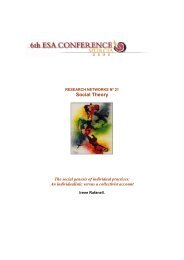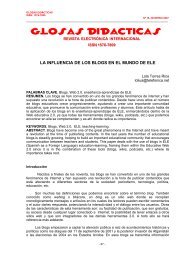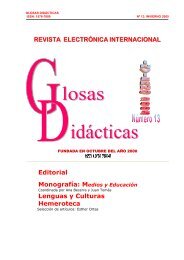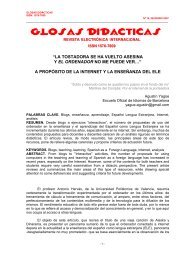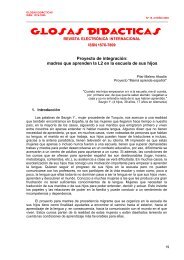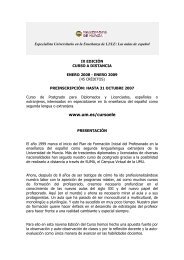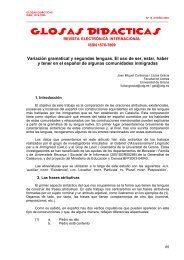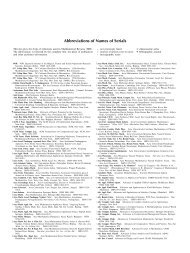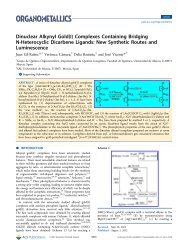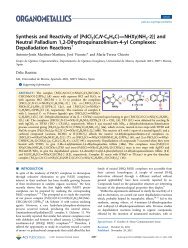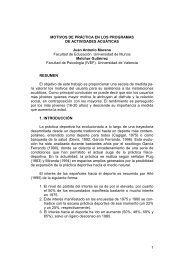Synthesis of gold (I), gold (III), and silver (I) complexes with ylide ...
Synthesis of gold (I), gold (III), and silver (I) complexes with ylide ...
Synthesis of gold (I), gold (III), and silver (I) complexes with ylide ...
Create successful ePaper yourself
Turn your PDF publications into a flip-book with our unique Google optimized e-Paper software.
Organometallics 1988, 7, 997-1006 997<br />
<strong>Synthesis</strong> <strong>of</strong> Gold( I), Gold( I I I), <strong>and</strong> Silver( I) Complexes <strong>with</strong><br />
Ylide Lig<strong>and</strong>s Derived from<br />
Car bony1 bis( met hylenetrip henylp hosp honium) Diperc hlotate.<br />
Crystal <strong>and</strong> Molecular Structures <strong>of</strong><br />
Jose Vicente, Maria-Teresa Chicote, <strong>and</strong> Isabel Saura-Llamas<br />
Depadamento de Quimica Inorganica, Universidad de Murcia, 30.07 1-Murcia, Spain<br />
Peter G. Jones, Karen Meyer-Base, <strong>and</strong> Cristina Freire Erdbrugger<br />
Institut fur Anorganische Chemie der Universitat, Tammannstrasse 4, 3400 Giittingen, West Germany<br />
Received July 7, 1987<br />
Transylidation reactions between the diphosphonium salt [(Ph3PCHz)zC0](C104)z<br />
<strong>and</strong> [M(CH-<br />
(PP~~)C(O)CH~IZIC~O~ (1:U (M = Ag, Au) give [Mz(~-((CH(PPh3)JzCOJ)zI(C104)z<br />
= Ag (l), Au (211.<br />
Complex 1 reacts <strong>with</strong> [AuCl(tht)](1:l; tht = tetrahydrothiophene) to give 2. This complex reacts <strong>with</strong><br />
an excess <strong>of</strong> chlorine to give trans-[ (AuClz)z(~-((CH(PPh3))zCO)Jz](C10~)z<br />
(3), but slow diffusion <strong>of</strong> the reacting<br />
solutions into each other gives instead the new diphosphonium salt [(Ph3PCC1z)zCO]<br />
[AuCl,] (C104)(3a).<br />
The diphosphonium salt [(Ph3PCH2)2CO] (C104)2 reacts <strong>with</strong> [AuC1(CH(PPh3)C(0)CH3}] leading to an<br />
equilibrium between the starting compounds <strong>and</strong> the products <strong>of</strong> successive transylidation reactions,<br />
[AuCl(CH(PPh3)C(O)CH~PPh3)]C104 (4) <strong>and</strong> [(AUC~)~(~L-((CH(PP~~)J~CO)J]<br />
(5). From the reaction mixture<br />
only 5 can be isolated as a pure compound. However, when the new <strong>ylide</strong>-phosphonium salt<br />
[Ph3PCHC(O)CHZPPh3]C1O4 is reacted <strong>with</strong> [AuCl(tht)], complex 4 can be isolated. It reacts <strong>with</strong><br />
[AuCl(CH(PPh3)C(0)CH3J] (1:l) to give 5, which, in turn, reacts <strong>with</strong> chlorine to give the <strong>gold</strong>(II1) complex<br />
[(AUC~~)~(~-((CH(PP~~))~CO))]<br />
(6). [Au(acac)L](acac = acetylacetonate) reacts <strong>with</strong> the diphosphonium<br />
salt [(Ph3PCH2)2CO](C104)z (molar ratio 2 4:l) to give <strong>complexes</strong> <strong>of</strong> the type [(AUL)~(~-(C(PP~,)C(O)-<br />
CH(PPh3)(AuL)JII(C10& [L = PPh3 (7)l or [(AUL)~(~L-((C(PP~~)),CO))~(C~O~)~<br />
[L = PhMezP (811. Single-crystal<br />
X-ray Btructure determinations were performed for compounds 2, 3a, 7, <strong>and</strong> 8. Compound 2<br />
possesses a central eight-membered ring <strong>with</strong> a short transannular Aw-Au contact <strong>of</strong> 2.876 A. Compound<br />
3a, the nature <strong>of</strong> which was only revealed by the X-ray study, contains centrosymmetric [AuC14]- anions,<br />
C104- anions, <strong>and</strong> the novel, highly chlorinated phosphonium ion [(Ph3PCC1z)zC0]2+.<br />
Compounds 7 <strong>and</strong><br />
8 contain triangular AuzC units (Au-Au = 2.86-3.01 A) to which three-center bonding probably makes<br />
a significant contribution; further short Aw-Au contacts are observed between the Auz groups <strong>and</strong> <strong>gold</strong><br />
atoms farther away (3.15-3.34 A). The Au-C-CO-C-Au backbone <strong>of</strong> compound 7 is disordered over two<br />
positions (occupation factors <strong>of</strong> ca. 89 <strong>and</strong> 11%); only the <strong>gold</strong> atoms <strong>of</strong> the minor disorder component<br />
could be identified.<br />
Introduction<br />
The acidic character <strong>of</strong> the methylene protons in the<br />
carbonyl-phosphonium salts [Ph3PCHzC(0)R]+ has allowed<br />
us to prepare dinuclear <strong>gold</strong>(1) <strong>complexes</strong>,<br />
[(AUL)~(~-C(PP~~)C(O)R~]+ (L = PPh3, R = OMe, OEt,l<br />
Me, Ph,2 L = AsPPh,, R = Me2), by reacting such onium<br />
salts <strong>with</strong> the corresponding [Au(acac)L] <strong>complexes</strong> (1:2<br />
molar ratio); the products display an unusual type <strong>of</strong> <strong>ylide</strong><br />
c~ordination.~ In this paper we report the extension <strong>of</strong><br />
this acid-base reaction starting from the diphosphonium<br />
salt [(Ph3PCH2)2CO] (C104)z from which we have succeeded<br />
in preparing tri- <strong>and</strong> tetranuclear <strong>gold</strong>(1) <strong>complexes</strong> containing<br />
the conjugate bases [Ph3PCC(0)CH(PPh3)]- <strong>and</strong><br />
[(Ph3PC)&0l2-.<br />
(1) Vicente, J.; Chicote, M. T.; Cayuelas, J. A.; Fern<strong>and</strong>ez-Baeza, J.;<br />
Jones, P. G.; Sheldrick, G. M.; Espinet, P. J. Chem. Soc., Dalton Trans.<br />
1985, 1163.<br />
(2) Vicente, J.; Chicote, M. T.; Saura-Llamas, I.; Turpin, J.; Fern<strong>and</strong>ez-Baeza,<br />
J. J. Organomet. Chem. 1987,333, 129.<br />
(3) Schmidbaur, H. Angew. Chem., Int. Ed. Engl. 1983, 22, 907.<br />
Kaska, W. C. Coord. Chem. Rev. 1983,48, 1.<br />
0276-7333/88/2307-0997$01.50/0<br />
In addition, we have synthesized <strong>complexes</strong> <strong>with</strong> the two<br />
other conjugate bases, the new <strong>ylide</strong>-phosphonium salt<br />
[Ph3PCHC(0)CH2PPh3]+ <strong>and</strong> the still unisolated45 di<strong>ylide</strong><br />
(Ph3PCH),C0. The Au(1) <strong>complexes</strong> <strong>of</strong> this di<strong>ylide</strong> lig<strong>and</strong>,<br />
<strong>and</strong> also one Ag(1) complex, have been obtained by transylidation<br />
reactions. This term is used to describe the<br />
acid-base reactions between an <strong>ylide</strong> <strong>and</strong> an onium salt6<br />
[e.g., R,PCHR’ + [R”,PCH2R”’]+ - R”,PCHR”’ +<br />
[R3PCHzR’]+], but we expect that it could be extended to<br />
those reactions between a coordinated <strong>ylide</strong> <strong>and</strong> an onium<br />
salt (a phosphonium salt in our case) to give <strong>complexes</strong><br />
<strong>with</strong> its conjugate base. We have not found any precedent<br />
for such a synthesis <strong>of</strong> <strong>ylide</strong> <strong>complexes</strong>.<br />
The di<strong>ylide</strong> (Ph3PCH)&0 belongs to the group <strong>of</strong><br />
triatomic bridging lig<strong>and</strong>s (A-C) that are usually designed<br />
to promote metal-metal bonds, unusual oxidation states<br />
[e.g. Au(II),’ Pd(I),8 Pt(I)g], <strong>and</strong> the synthesis <strong>of</strong> hetero-<br />
(4) Ford, J. A,; Wilson, C. V. J. Org. Chem. 1961, 26, 1433.<br />
(5) Denney, D. B.; Song, J. J. Org. Chem. 1964,29, 495.<br />
(6) Schmidbaur, H. Acc. Chem. Res. 1975, 8, 62.<br />
0 1988 American Chemical Society
998 Organometallics, Vol. 7, No. 4, 1988 Vicente et al.<br />
A B C<br />
bimetallic <strong>complexes</strong>;1° some examples are lig<strong>and</strong>s <strong>of</strong> type<br />
B having a CPC skeleton (e.g., anionic <strong>ylide</strong>s)6 <strong>and</strong> type<br />
C having a PCP bridge [e.g., <strong>complexes</strong> <strong>with</strong> bis(dipheny1phosphino)methanel.<br />
However, CCC-bridging lig<strong>and</strong>s<br />
(type A), such as (Ph3PCH)zC0, are very rare.9b<br />
Di<strong>ylide</strong> lig<strong>and</strong>s having a carbon chain between both<br />
carbon donor atoms are also very unusual. As far as we<br />
know there are only a few <strong>complexes</strong> <strong>with</strong> such lig<strong>and</strong>s,<br />
coordinated to Ni(I1)" [e.g., [Ni(CH(PPh3)-<br />
(cH,),CHPPh3}(?'-C5H5)]PF6; n = 1-31 <strong>and</strong> Sn(IV)12 [e.g.,<br />
[SnR,C14$R'(PPh3)C(0)(CH2),C(O)CR'PPh3]] (R = Me,<br />
Ph; x = 1-3; R' = H, Me, C0,Me; n = 0,2)], but in these<br />
<strong>complexes</strong> the di<strong>ylide</strong>s are probably chelating lig<strong>and</strong>s,<br />
whereas in the <strong>complexes</strong> reported here they are bridging<br />
lig<strong>and</strong>s.<br />
Results <strong>and</strong> Discussion<br />
The reactions <strong>of</strong> [M(CH(PPh3)C(0)CH3)z]C10, (M =<br />
Ag,13 Au') <strong>with</strong> [(Ph3PCHz)zCO](C10,)z(1:l) in acetone<br />
lead to the precipitation <strong>of</strong> <strong>complexes</strong> 1 <strong>and</strong> 2 as acetone<br />
l,M=Ag<br />
2. M=Au<br />
solvates. The solvent <strong>of</strong> crystallization can easily be removed.14<br />
From the mother liquors the phosphonium salt<br />
[Ph3PCHZC(O)CHB]C1O4 can be isolated by adding diethyl<br />
ether. This transylidation reaction (see Introduction) is<br />
probably successful because <strong>of</strong> the insolubility <strong>of</strong> <strong>complexes</strong><br />
1 <strong>and</strong> 2. An alternative synthesis <strong>of</strong> complex 2 (eq<br />
1) makes use <strong>of</strong> a recently reported3J3J5 synthesis <strong>of</strong> <strong>ylide</strong><br />
<strong>complexes</strong> by "<strong>ylide</strong> transfer reactions",*' which involve<br />
the transfer <strong>of</strong> an <strong>ylide</strong> lig<strong>and</strong> from one metal center to<br />
Figure 1. Crystal structure <strong>of</strong> the cation <strong>of</strong> compound 2. Radii<br />
are arbitrary, <strong>and</strong> phenyl H are omitted for clarity.<br />
another. In our case there is a double "<strong>ylide</strong> transfer" from<br />
<strong>silver</strong> to <strong>gold</strong>. This procedure gives 2 in a better yield.<br />
[ABZICL-((CH(PP~~)}~C~I]~I<br />
(C104h + 2[AuCl(tht)l -<br />
1<br />
[AuZ(/L-{{CH(PP~~))&O))Z] (C104)2 + 2AgC1 + 2tht (1)<br />
2<br />
The structure <strong>of</strong> this complex has been determined by<br />
single-crystal X-ray methods (Figure 1). The presence<br />
<strong>of</strong> disordered solvent <strong>of</strong> crystallization was responsible for<br />
the low precision <strong>of</strong> this structure, but the basic features<br />
are clear. The cations contain the eight-membered rings<br />
that are a common feature <strong>of</strong> <strong>gold</strong>(1) chemistry;l' crystallographic<br />
inversion symmetry is imposed. The transannular<br />
<strong>gold</strong>-<strong>gold</strong> distance, formally nonbonded, is 2.876<br />
A; such contacts are also well-known for <strong>gold</strong>(I).18 There<br />
is considerable deviation from linearity at <strong>gold</strong> (170°),<br />
presumably to avoid yet shorter contacts between the <strong>gold</strong><br />
atoms. The four carbon atoms bonded to the <strong>gold</strong> atoms<br />
are chiral. However, because <strong>of</strong> the existence <strong>of</strong> the center<br />
<strong>of</strong> inversion, the molecule is one <strong>of</strong> the meso forms.<br />
When a suspension <strong>of</strong> 2 in dichloromethane is treated<br />
<strong>with</strong> a saturated solution <strong>of</strong> chlorine in carbon tetrachloride,16<br />
complex 3 is formed as a yellow precipitate.<br />
0<br />
(7) See, for example: Schmidbaur, H.; Hartmann, C.; Riede, J.; Huber,<br />
B.; Mtiller, G. Organometallics 1986,5,1652. Murray 111, H. H.; Fackler,<br />
J. P., Jr.; Porter, L. C.; Mazany, A. M. J. Chem. SOC., Chem. Commun.<br />
1986, 321.<br />
(8) See, for example: Espinet, P.; Fornies, J.; FortuAo, C.; Hidalgo, G.;<br />
Martinez, F.; Tomas, M. J. Organomet. Chem. 1986, 317, 105.<br />
(9) See, for example: Fisher, J. R.; Mills, A. J.; Sumner, S.; Brown, M.<br />
P.; Thompson, M. A.; Puddephatt, R. J.; Frew, A. A.; Manojlovic-Muir,<br />
L.; Muir, K. N. Organometallics 1982, 1, 1421.<br />
(10)(a) See, for example: Carr, S. W.; Shaw, B. L.; Thomton-Pett, M.<br />
J. Chem. SOC., Dalton Tram, 1985,213. (b) Fontaine, X. L. R.; Jacobsen,<br />
G. B.; Shaw, B. L.; Thornton-Pett, M. J. Chem. SOC., Chem. Commun.<br />
1987,662.<br />
(11) Booth, B. L.; Smith, K. G. J. Organomet. Chem. 1981,220, 229.<br />
(12) Sanchi, R. R.; Bonsal, K.; Mehrotra, R. C. J. Organomet. Chem.<br />
1986, 303, 351.<br />
(13) Vicente, J.; Chicote, M. T.; Fern<strong>and</strong>ez-Baeza, J.; Martin, J.;<br />
Saura-Llamas, I.; Turpin, J.; Jones, P. G. J. Organomet. Chem. 1987,331,<br />
409.<br />
(14) By heating in the solid state at 60 "C for 3 h. In the case <strong>of</strong> 2<br />
recrystallization from dichloromethane/diethyl ether gives crystals that<br />
readily lose solvent to give the unsolvated complex.<br />
(15) Uson, R.; Laguna, A.; Laguna, M.; Uson, A,; Gimeno, M. C. Organometallics<br />
1987, 6, 682.<br />
(16) Either stoichiometric or excess chlorine or PhIC12 (2:PhIC12 = 1:2)<br />
can be used as chlorinating agents.<br />
0<br />
3<br />
Complex 3 is not very stable <strong>and</strong> slowly decomposes at<br />
room temperature to give the starting complex 2 among<br />
other products. When the chlorination was carried out by<br />
slow diffusion <strong>of</strong> the reacting solutions (in an attempt to<br />
obtain single crystals <strong>of</strong> 3), the diphosphonium salt<br />
[(Ph3PCC12)zCO]<br />
[AuCl,](C104)(3a) was obtained instead.<br />
The nature <strong>of</strong> compound 3a was revealed by an X-ray<br />
diffraction study (Figures 2 <strong>and</strong> 3). The cations occupy<br />
general positions, <strong>and</strong> there are two independent [AuC14]-<br />
anions (both lying on centers <strong>of</strong> symmetry) <strong>and</strong> one general<br />
C10; anion. The [AuC14]- ions show no unusual features;<br />
the average Au-C1 bond length is 2.276 A.19 Of more<br />
interest is the cation; we are not aware <strong>of</strong> any other<br />
phosphonium cations bearing the Cl2C-C0-CCl2 moiety.<br />
(17) Jones, P. G. Gold Bull. 1981,14,102; 1983,16, 114; 1986,19,46.<br />
(18) Jiang, Y.; Alvarez, S.; H<strong>of</strong>fmann, R. Inorg. Chem. 1985,24,749.<br />
(19) Jones, P. G. Gold Bull. 1981, 14, 159.<br />
J
<strong>Synthesis</strong> <strong>of</strong> Ad, Au"', <strong>and</strong> AgI Complexes <strong>with</strong> Ylide Lig<strong>and</strong>s Organometallics, Vol. 7, No. 4, 1988 999<br />
Table I. Details <strong>of</strong> Data Collection <strong>and</strong> Structure Refinement<br />
2 ~<br />
3a 7 8<br />
formula C7sHMA~202P~+ C3gH&140P;+ C~~H~~AU~OP?' C11H14A~40P62+<br />
2c104- AuC14-C104- 2C104- 2c10,<br />
fw<br />
a<br />
space group pi<br />
cell consts<br />
a (A) 13.104 (5)<br />
b (A) 13.737 (7)<br />
c (A) 14.105 (5)<br />
CY (deg) 62.42 (3)<br />
P (deg) 88.55 (5)<br />
Y (deg) 71.38 (4)<br />
v (A3) 2110<br />
Z 1<br />
Ddcd (g ~ m-~) a<br />
F(000)<br />
a<br />
P ("3 3.8<br />
cryst size (mm); habit 0.25 X 0.1 X 0.1;<br />
colorless prism<br />
transmissn 0.61-0.75<br />
28, (ded 45<br />
reflectns<br />
measd 9605<br />
unique 5483<br />
Rint 0.063<br />
obsd 3882<br />
R 0.098<br />
Rw 0.090<br />
g 0.001<br />
parameters 163<br />
a Uncertain because <strong>of</strong> solvent <strong>of</strong> crystallization<br />
1157<br />
R1In<br />
8.476 (2)<br />
36.244 (5)<br />
14.156 (2)<br />
90<br />
95.66 (2)<br />
90<br />
4327<br />
4<br />
1.78<br />
2264<br />
4.0<br />
0.4 X 0.25 X 0.15;<br />
yellow prism<br />
0.55-0.66<br />
50<br />
11 906<br />
7573<br />
0.031<br />
4913<br />
0.069<br />
0.060<br />
0.0002<br />
241<br />
a<br />
Pi<br />
2116<br />
mln<br />
13.352 (4) 14.746 (3)<br />
18.127 (7) 17.914 (4)<br />
19.109 (7) 28.009 (6)<br />
95.67 (4) 90<br />
99.14 (4) 92.80 (2)<br />
92.04 (4) 90<br />
4538 7390<br />
2 4<br />
a 1.90<br />
a 4048<br />
5.0 8.2<br />
0.45 X 0.25 X 0.1; colorless plate 0.45 X 0.4 X 0.3 colorless prism<br />
0.614.97<br />
44<br />
11 715<br />
11077<br />
0.036<br />
7508<br />
0.078<br />
0.069<br />
0.00035<br />
336<br />
0.46-0.83<br />
45<br />
11 058<br />
9614<br />
0.037<br />
9614<br />
0.065<br />
0.053<br />
0.0002<br />
342<br />
Figure 2. Crystal structure <strong>of</strong> the cation <strong>of</strong> compound 3a. Radii<br />
we arbitrary, <strong>and</strong> H atoms are omitted.<br />
4<br />
i<br />
C104 +<br />
0<br />
II<br />
The bond angle at the sp2 carbon, C(l)-C(2)-C(3), is wide<br />
(125.2O). The P-C(sp3) bond lengths are, as expected,<br />
significantly shorter than P-C(sp2) bond lengths (average<br />
1.887 <strong>and</strong> 1.776 A, respectively). The conformation <strong>of</strong> the<br />
cations is somewhat unexpected; looking along the direction<br />
<strong>of</strong> C(l)-C(3), the substituents are staggered but the<br />
bulky phosphine groups are "synclinal". It is not yet clear<br />
how compound 3a was formed, although a radical mechanism<br />
cannot be ruled out (the reaction mixture was not<br />
protected from light).<br />
The reaction <strong>of</strong> 2 <strong>with</strong> PhIC12 in 1:l molar ratio did not<br />
give the desired <strong>gold</strong>(I1) complex [(AuC~)~{~-((CH-<br />
(PPh3)]2CO))2](C104)2. Instead, a mixture <strong>of</strong> 2 <strong>and</strong> 3 was<br />
obtained. It is likely that the coordination sites for the<br />
chlorine lig<strong>and</strong>s' were too crowded (see Figure 1).<br />
The transylidation reaction shown in eq 2 gives a mixture<br />
<strong>of</strong> products from which, by suitable treatment, 5 <strong>and</strong><br />
unreacted phosphonium salt can be isolated as the only<br />
pure compounds. The result can be understood if two<br />
stepwise transylidation reactions in equilibrium are assumed.<br />
The presence <strong>of</strong> the intermediate 4 in the mixture<br />
was postulated from IR evidence (see below). This compound<br />
was later synthesized by treating the <strong>ylide</strong>phosphonium<br />
salt [Ph3PCHC(0)CH2PPh3]C104 <strong>with</strong><br />
[AuCl(tht)], but it always was contaminated <strong>with</strong> trace<br />
amounts <strong>of</strong> [(Ph,PCH2)2CO](C104)2 <strong>and</strong> 5 (by IR <strong>and</strong> 31P<br />
NMR spectroscopy). These are the products <strong>of</strong> the intermolecular<br />
transylidation reaction <strong>of</strong> 4. Complex 5 can<br />
also be obtained by the transylidation reaction between<br />
4 <strong>and</strong> [AuCl{CH(PPh,)C(O)CH,)]. The reaction <strong>of</strong> 5 <strong>with</strong><br />
chlorine gives the <strong>gold</strong>(II1) complex 6. The reactions<br />
0<br />
I1<br />
8<br />
between [(Ph3PCH2)2CO]<br />
(C104)2 <strong>and</strong> [Au(acac)L](molar<br />
ratio <strong>of</strong> 1:4) give the trinuclear complex [(AuL),(p-(C-<br />
(PPh~C(0)CH(PPh,)(AuL)j)](C104)2 [L = PPh, (7)] or the<br />
[L =<br />
PhMezP (811 (see Figures 4-7). It is probable that steric<br />
hindrance prevents the tetrasubstitution when L = PPh,<br />
(even if molar ratios less than 1:4 were used) because it<br />
is attained <strong>with</strong> the less bulky phosphine MezPhP (complex<br />
8, see Figures 6 <strong>and</strong> 7). These reactions are <strong>of</strong> the<br />
tetranuclear [(AuL)~(~-({C(PP~,))~CO)}](C~O~)~<br />
CI<br />
5<br />
CI
1000 Organometallics, Vol. 7, No. 4, 1988 Vicente et al.<br />
8, L 1 PMezPh<br />
same type as those previously reported by us',, between<br />
[Au(acac)L] (L = PPh,, AsPh,) <strong>and</strong> the monophosphonium<br />
salts [Ph3PCH2COR]C104(R = MeO, EtO,<br />
Me, Ph) which give dinuclear [(AuL),{p-C(PPh,)C(O)-<br />
R)]C104 <strong>complexes</strong> <strong>and</strong> acetylacetone.<br />
All the <strong>complexes</strong> show molar conductivities in acetone<br />
or acetonitrile consistent <strong>with</strong> their formulations. The<br />
molecular weight <strong>of</strong> 5, determined osmometrically in<br />
chlor<strong>of</strong>orm, is also consistent <strong>with</strong> its dinuclear formulation.<br />
The crystal structures <strong>of</strong> compounds 7 <strong>and</strong> 8 were determined.<br />
Crystals <strong>of</strong> 7 diffracted weakly <strong>and</strong> contained<br />
a solvent <strong>of</strong> crystallization that was easily lost to the atmosphere;<br />
these solvent molecules could not be refined<br />
adequately (two regions <strong>of</strong> ill-defined electron density<br />
correspond to disordered solvent), <strong>and</strong> the corresponding<br />
precision is low, as was the case for complex 2. Initial<br />
attempts to solve the structure <strong>of</strong> 7 proved puzzling; three<br />
<strong>gold</strong> atoms <strong>and</strong> five triphenylphosphine moieties were<br />
located <strong>with</strong>out difficulty, but the remaining electron<br />
density showed impossibly short contacts between "atoms".<br />
This was interpreted as a tw<strong>of</strong>old disorder; the phosphines<br />
form a "cage" <strong>with</strong>in which the backbone <strong>of</strong> the molecule<br />
can adopt two different orientations (see Figures 4 <strong>and</strong> 5,<br />
parts a <strong>and</strong> b). The sites Au(1') <strong>and</strong> Au(3') are occupied<br />
to the extent <strong>of</strong> 11.4%. In view <strong>of</strong> these problems, the<br />
molecular dimensions should be discussed <strong>with</strong> caution.<br />
The structure determination <strong>of</strong> complex 8 produced no<br />
such disorder problems. Because 7 <strong>and</strong> 8 are chemically<br />
so similar, their structures will be discussed together.<br />
However, the minor disorder component <strong>of</strong> 7 will not be<br />
discussed further. Both compounds contain triangular<br />
AuzC units (see Figures 4-7) <strong>of</strong> the type that we had already<br />
observed in a binuclear complex' <strong>and</strong> that we had<br />
interpreted in terms <strong>of</strong> a closed three-center, two-electron<br />
bond. The Au-Au bond lengths are 2.892 A,' 2.862 8,<br />
(compound 7) <strong>and</strong> 2.950 <strong>and</strong> 3.008 A (compound 8), <strong>with</strong><br />
corresponding Au-C-Au angles <strong>of</strong> 86.3, 85.9, 88.9, <strong>and</strong><br />
91.1O. The larger angles <strong>and</strong> longer bonds in 8 suggest that<br />
the three-center bonding contributes less to the overall<br />
bonding scheme in this compound. The precision <strong>of</strong> the<br />
P-C bond lengths does not allow a comparison <strong>of</strong> the bond<br />
orders.<br />
Short Au...Au contacts are observed between the Au,<br />
units <strong>of</strong> 8 <strong>and</strong> from Au, to the single Au atom in 7. These<br />
contacts, as mentioned above, are a common feature <strong>of</strong> the<br />
structural chemistry <strong>of</strong> <strong>gold</strong>(I)"J8 (see Figures 5, parts a<br />
<strong>and</strong> b, <strong>and</strong> 7). They are significantly longer (3.227 8, in<br />
7 <strong>and</strong> 3.149, 3.307, <strong>and</strong> 3.343 A in 8) than the assumed<br />
three-center bonding interactions. It is, therefore, more<br />
suitable to regard the Au, units as separate groups <strong>with</strong><br />
Table 11. Atomic Coordinates (X104) <strong>and</strong> Equivalent<br />
Isotropic Displacement Parameters (A2 X loa) for<br />
Compound 2<br />
X Y z Wed, A'<br />
Au 4435 (1) 4676 (1) 923 (1) 39<br />
4993 (6) 1924 (5)<br />
2975 (5) 6942 (5)<br />
6812 (13) 2151 (12)<br />
4880 (17) 3022 (16)<br />
5898 (18) 2890 (18)<br />
4129 (18) 6415 (18)<br />
3704 (12) 2259 (13)<br />
2707 2611<br />
1740 3091<br />
1771 3218<br />
2768 2865<br />
3735 2385<br />
6578 (14) 623 (12)<br />
7407 443<br />
7769 1357<br />
7300 2453<br />
6471 2633<br />
6109 1718<br />
4445 (12) -54 (14)<br />
4586 -1174<br />
5461 -1746<br />
6195 -1197<br />
6053 -77<br />
C(31) 5178<br />
C(42) 3849 (14)<br />
C(43) 4008<br />
C(44) 3561<br />
C(45) 2955<br />
C(46) 2796<br />
C(41) 3243<br />
C(52) 3498 (11)<br />
C(53) 3300<br />
C(54) 2274<br />
C(55) 1445<br />
C(56) 1643<br />
C(51) 2669<br />
C(62) 1739 (12)<br />
C(63) 836<br />
(364) 6<br />
C(65) 78<br />
C(66) 980<br />
C(61)<br />
C1<br />
1811<br />
2790 (7)<br />
O(2) 1971 (29)<br />
O(3) 2820 (35)<br />
O(4) 2435 (28)<br />
O(5) 3802 (25)<br />
O(6) 2588 (35)<br />
O(7) 3176 (32)<br />
O(8) 3632 (22)<br />
O(9) 1844 (25)<br />
494<br />
5109 (14)<br />
4566<br />
5214<br />
6405<br />
6948<br />
6300<br />
8860 (14)<br />
10048<br />
10870<br />
10506<br />
9319<br />
8496<br />
6413 (14)<br />
6178<br />
6179<br />
6416<br />
6652<br />
6650<br />
4152 (7)<br />
5280 (23)<br />
3495 (32)<br />
3613 (28)<br />
4261 (45)<br />
4875 (36)<br />
2961 (21)<br />
4369 (25)<br />
4427 (45)<br />
2368 (5)<br />
1163 (5)<br />
1086 (11)<br />
988 (16)<br />
505 (17)<br />
633 (18)<br />
3875 (12)<br />
4212<br />
3510<br />
2471<br />
2133<br />
2836<br />
4167<br />
4895<br />
4715<br />
3807<br />
3079<br />
3259<br />
3062<br />
3226<br />
2869<br />
2348<br />
2184<br />
2541<br />
3190 (15)<br />
4317<br />
4844<br />
4244<br />
3117<br />
2590<br />
806 (13)<br />
433<br />
-101<br />
-262<br />
111<br />
645<br />
22 (12)<br />
-191<br />
447<br />
1299<br />
1513<br />
874<br />
8195 (7)<br />
7826 (36)<br />
9328 (16)<br />
7681 (24)<br />
7924 (38)<br />
8695 (36)<br />
9009 (30)<br />
7559 (24)<br />
7533 (30)<br />
" Equivalent isotropic U defined as one-third <strong>of</strong> the trace <strong>of</strong> the<br />
orthogonalized Uij tensor.<br />
Table 111. Bond Lengths (A) <strong>and</strong> Angles (deg) for<br />
Compound 2<br />
Bond Lengths<br />
Au-C(l) 2.115 (18) Au-C(3) 2.128 (21)<br />
P(l)-C(l) 1.799 (20) P(l)-C(ll) 1.794 (18)<br />
P(l)-C(21) 1.818 (18) P(l)-C(31) 1.797 (17)<br />
P(Z)-C(3) 1.764 (22) P(2)-C(41) 1.774 (19)<br />
P(2)-C(51) 1.810 (17) P(2)-C(61) 1.797 (17)<br />
0(1)-C(2) 1.280 (23) C(l)-C(2) 1.480 (26)<br />
Au-Au' 2.876<br />
Bond Angles<br />
C(3)-Au-C(1) 170.5 (8) P(I)-C(l)-Au 108.7 (9)<br />
C(2)-C(l)-Au 105.4 (13) C(2)-C(l)-P(l) 115.1 (15)<br />
O(l)-C(2)-C(3)' 118.6 (19) C(l)-C(2)-C(3)'' 119.9 (19)<br />
C(l)-C(2)-0(1) 121.1 (18) Au-C(3)-C(2)" 106.4 (13)<br />
P(2)-C(3)-Au 113.2 (11) P(2)-C(3)-C(2Y 115.7 (14)<br />
Symmetry operator: 1 - n, 1 - y, -2.
<strong>Synthesis</strong> <strong>of</strong> Ad, Ad1', <strong>and</strong> Ag' Complexes <strong>with</strong> Ylide Lig<strong>and</strong>s Organometallics, Vol. 7, No. 4, 1988 1001<br />
Table IV. Atomic Coordinates (XlO') <strong>and</strong> Equivalent<br />
Isotropic Displacement Parameters (AZ X lo3) for<br />
Compound 3a<br />
AuU)<br />
Ad21<br />
CU1)<br />
Cl(2)<br />
Cl(3)<br />
CU4)<br />
CU5)<br />
O(1)<br />
O(2)<br />
00)<br />
O(4)<br />
P(1)<br />
P(2)<br />
Cl(11)<br />
Cl(12)<br />
Cl(31)<br />
Cl(32)<br />
C(1)<br />
C(2)<br />
O(21)<br />
C(3)<br />
C(212)<br />
C(213)<br />
C(214)<br />
C(215)<br />
(3216) -<br />
C(2ll)<br />
C(222)<br />
C(223)<br />
C(224)<br />
C(225)<br />
C(226)<br />
C(221)<br />
C(232)<br />
C(233)<br />
C(234)<br />
C(235)<br />
C(236)<br />
C(231)<br />
C(112)<br />
C(113)<br />
C(114)<br />
C(115)<br />
C(116)<br />
C(111)<br />
C(122)<br />
C(123)<br />
C(124)<br />
C(125)<br />
C(126)<br />
C(121)<br />
C(132)<br />
C(133)<br />
C(134)<br />
C(135)<br />
C(136)<br />
C(131)<br />
0<br />
5000<br />
1205 (4)<br />
-2046 (4)<br />
4818 (6)<br />
7491 (5)<br />
2670 (3)<br />
2537 (10)<br />
3633 (8)<br />
1136 (8)<br />
3440 (12)<br />
1986 (3)<br />
659 (3)<br />
-860 (3)<br />
-2115 (3)<br />
-1400 (3)<br />
-47 (3)<br />
-374 (10)<br />
801 (10)<br />
2192 (7)<br />
338 (10)<br />
-1256 (7)<br />
-2523<br />
-3435<br />
-3080<br />
-1814<br />
-902<br />
3386 (6)<br />
4288<br />
3551<br />
1913<br />
1011<br />
1747<br />
2057 (7)<br />
3034<br />
3847<br />
3684<br />
2707<br />
1893<br />
1804 (6)<br />
2455<br />
4073<br />
5041<br />
4391<br />
2772<br />
4324 (8)<br />
5559<br />
5953<br />
5111<br />
3876<br />
3482<br />
521 (8)<br />
-300<br />
-543<br />
36<br />
857<br />
1100<br />
0<br />
0<br />
-11 (1)<br />
328 (1)<br />
504 (1)<br />
184 (1)<br />
2151 (1)<br />
2340 (3)<br />
1836 (2)<br />
2043 (2)<br />
2387 (3)<br />
1204 (1)<br />
1543 (1)<br />
892 (1)<br />
1623 (1)<br />
1114 (1)<br />
1856 (1)<br />
1363 (2)<br />
1377 (2)<br />
1369 (2)<br />
1388 (2)<br />
2017 (1)<br />
2094<br />
1807<br />
1442<br />
1365<br />
1653<br />
1946 (1)<br />
2236<br />
2522<br />
2516<br />
2226<br />
1941<br />
1239 (1)<br />
995<br />
718<br />
686<br />
930<br />
1206<br />
533 (2)<br />
252<br />
252<br />
533<br />
814<br />
813<br />
1524 (2)<br />
1771<br />
2038<br />
2059<br />
1812<br />
1545<br />
1379 (1)<br />
1295<br />
928<br />
645<br />
729<br />
1096<br />
0<br />
5000<br />
1512 (2)<br />
500 (2)<br />
4034 (3)<br />
5540 (4)<br />
2524 (2)<br />
3382 (8)<br />
2700 (5)<br />
2115 (6)<br />
1910 (7)<br />
5781 (2)<br />
9444 (2)<br />
8436 (2)<br />
7981 (2)<br />
6109 (2)<br />
6150 (2)<br />
8290 (6)<br />
7533 (6)<br />
7787 (4)<br />
6445 (6)<br />
10357 (4)<br />
10884<br />
11197<br />
10982<br />
10455<br />
10142<br />
9385 (4)<br />
9077<br />
8537<br />
8306<br />
8614<br />
9154<br />
11050 (4)<br />
11600<br />
11163<br />
10176<br />
9626<br />
10064<br />
6718 (4)<br />
7308<br />
7607<br />
7316<br />
6725<br />
6426<br />
4885 (4)<br />
4781<br />
5473<br />
6270<br />
6375<br />
5682<br />
4030 (5)<br />
3154<br />
2883<br />
3489<br />
4365<br />
4636<br />
"Equivalent isotropic U defined as one-third <strong>of</strong> the trace <strong>of</strong> the<br />
orthogonalized Uij tensor.<br />
additional slight bonding interactions rather than as parts<br />
<strong>of</strong> tri- or tetranuclear clusters. The bond angles P-Au-C<br />
all deviate somewhat from the linear geometry <strong>of</strong> simple<br />
<strong>gold</strong>(1) <strong>complexes</strong>: the range is 166-174O <strong>and</strong> the average<br />
<strong>of</strong> seven bonds 170.6'.<br />
The Au2 units <strong>of</strong> 8 are not eclipsed; a Newman-type<br />
projection along C(l)-C(3) shows a mutual rotation <strong>of</strong> ca.<br />
40' similar to that <strong>of</strong> the cation in compound 3a. In<br />
complex 7 the single <strong>gold</strong> atom Au(3) is rotated away from<br />
the Au2 unit by ca. 37O in a similar Newman projection (see<br />
Figures 2,5a, <strong>and</strong> 7). The C(3) atom is chiral (see Figures<br />
4 <strong>and</strong> 5a), but both enantiomers are present in the crystal.<br />
Table V. Bond Lengths (A) <strong>and</strong> Angles (deg) for<br />
Compound 3a<br />
Bond I<br />
Au( l)-Cl( 1)<br />
Au(2)-C1(3)<br />
C1(5)-0(1)<br />
C1(5)-0(3)<br />
2.280 (3)<br />
2.279 (4)<br />
1.409 (9)<br />
1.425 (7)<br />
2.272 (3)<br />
2.273 (4)<br />
1.410 (7)<br />
1.424 (9)<br />
P(1)-C(3) 1.882 (9)<br />
1.777 (7)<br />
P (1)-c (12 1) 1.787 (6)<br />
1.761 (7)<br />
P(2)-C(U<br />
P(2)-C(221)<br />
Cl(ll)-C(l)<br />
C1(31)-C(3)<br />
C(l)-C(2)<br />
1.893 (8)<br />
1.782 (6)<br />
1.773 (9)<br />
1.802 (9)<br />
1.534 (12)<br />
1.771 (6)<br />
1.782 (6)<br />
1.770 (9)<br />
1.768 (9)<br />
1.199 (10)<br />
C(2)-C(3) 1.552 (11)<br />
Bond Angles<br />
Cl(2)-A~(l)-Cl(l) 90.1 (1) C1(4)-Au(2)-C1(3) 88.4 (2)<br />
0(2)-C1(5)-0(1) 109.6 (6) 0(3)-C1(5)-0(1) 109.7 (5)<br />
0(3)-C1(5)-0(2) 109.8 (5) 0(4)41(5)-0(1) 108.3 (7)<br />
0(4)-C1(5)-0(2) 107.6 (5) 0(4)-C1(5)-0(3) 111.8 (6)<br />
C(lll)-P(l)-C(3) 106.6 (3) C(l2l)-P(l)-C(3) 111.1 (3)<br />
c(l2l)-P(l~-c(lll~ 111.0 (3) C(13l)-P(l)-C(3)<br />
C(l3l)-P(l)-C(lll) 113.7 (3) C(l31)-P(l)-C(l21)<br />
105.5 (4)<br />
108.8 (3)<br />
C(2ll)-P(2)-C(l) 104.5 (3) C(221)-P(2)-C(l) 106.6 (3)<br />
C(221)-P(2)-C(211) 112.4 (3) C(231)-P(2)-C(l)<br />
C(231)-P(2)-C(211) 108.3 (3) C(231)-P(2)-C(221)<br />
112.7 (3)<br />
112.1 (3)<br />
Cl(ll)-C(l)-P(2) 109.0 (4) C1(12)-C(l)-P(2) 109.4 (4)<br />
cl(l2)-c(l)-cl(ll~ 110.2 (5) C(2)-C(l)-P(2) 108.4 (6)<br />
C( 2)-C( l)-C1( 11) 106.7 (6) C (2)-C( l)-Cl( 12) 113.1 (6)<br />
0(21)-C(2)-C(l) 118.5 (8) C(3)4(2)-C(l) 125.2 (7)<br />
C(3)-C(2)-0(21) 116.3 (8) Cl(3l)-C(3)-P(l) 107.5 (4)<br />
C1(32)-C(3)-P(l) 110.6 (5) C1(32)-C(3)-C1(31) 109.9 (5)<br />
C(2)-C(3)-P(l) 111.0 (6) C(2)-C(3)-C1(31) 111.5 (6)<br />
C(2)-C(3)-C1(32) 106.4 (6) C1(3)-A~(2)-C1(4)~ 91.6 (1)<br />
Cl(l)-Au(l)-Cl(2)" 89.9 (1)<br />
'Symmetry operator: -x, -y,-2. *Symmetry operator: 1 - x,<br />
-y, 1 - 2.<br />
The v(C0) frequency for all the <strong>complexes</strong> is lower by<br />
25-210 cm-l than that <strong>of</strong> the diphosphonium salt (1715<br />
cm-'). This is a well-established effect in <strong>silver</strong> <strong>and</strong> <strong>gold</strong><br />
<strong>complexes</strong> containing other carbonyl-stabilized phosphorus<br />
<strong>ylide</strong>s.'p2 In general, the value <strong>of</strong> the v(C0) frequency is<br />
lower as a consequence <strong>of</strong> the substitution <strong>of</strong> hydrogen by<br />
less electronegative groups, <strong>and</strong>, correspondingly, when<br />
similar <strong>complexes</strong> are compared, the v(C0) frequencies<br />
follow the order Ag(1) > Au(1) <strong>and</strong> Au(1) > Au(II1). The<br />
number <strong>of</strong> substituted hydrogen atoms has a notable influence<br />
on v(C0). Thus in 4 it appears at 1650 cm-' while<br />
in 5 it is observed at 1600 cm-l. Trisubstitution, as in 7,<br />
decreases this value to 1560 cm-l, <strong>and</strong>, finally, tetrasubstitution<br />
leads to the lowest value (1505 cm-' in 8).<br />
The values <strong>of</strong> the Au-C1 stretching frequency trans to<br />
the <strong>ylide</strong> lig<strong>and</strong> (vt) in 4 <strong>and</strong> 5 (320 cm-') are very similar<br />
to those found's2 in <strong>complexes</strong> <strong>of</strong> formula [AuCl(<strong>ylide</strong>)].<br />
The three b<strong>and</strong>s observed in complex 6 at 310 (s), 330 (w),<br />
<strong>and</strong> 350 (s) cm-l can be assigned to ut, us,(AuC12), <strong>and</strong><br />
Y,~(AuC~~) according to the above <strong>and</strong> other'p2 assignments<br />
in <strong>complexes</strong> <strong>of</strong> the same stoichiometry. Accordingly,<br />
the b<strong>and</strong> at 370 (br, m) cm-' in 3 allows us to assign<br />
to it a trans geometry as in several [A~Cl~(<strong>ylide</strong>)~]+ complexe~.~~~,~~<br />
A cis geometry should give rise to two b<strong>and</strong>s<br />
around 320 cm-'.<br />
The limited solubility <strong>of</strong> all the <strong>complexes</strong>, except 4,7,<br />
<strong>and</strong> 8, in organic solvents has prevented us from recording<br />
their NMR spectra. These could have informed us about<br />
the relative proportions <strong>of</strong> diastereoisomers present in<br />
solution <strong>of</strong> such <strong>complexes</strong> because they have two (<strong>complexes</strong><br />
5 <strong>and</strong> 6) or four (<strong>complexes</strong> 1-3) chiral centers.<br />
(20) Schmidbaur, H. Gmelin H<strong>and</strong>buch der Anorganischen Chemie,<br />
Organo<strong>gold</strong> Compounds; Springer-Verlag, Berlin, 1980.
1002 Organometallics, Vol. 7, No. 4, 1988 Vicente et al.<br />
Table VI. Atomic Coordinates (XlO') <strong>and</strong> Eauivalent Isotropic Disdacement Parameters (Ae X lo3) for Compound 7<br />
X Y z Wed X Y z Wed<br />
AuO) 1777 (1) 1922 (1) 2537 (1) 38 (1)" C(434) 1888 1679 -556 112 (10)<br />
AuW<br />
Au(3)<br />
P(1)<br />
P(2)<br />
P(3)<br />
P(4)<br />
P(5)<br />
C(212)<br />
C(213)<br />
C(214)<br />
C(215)<br />
C(216)<br />
C(211)<br />
C(222)<br />
C(223)<br />
C(224)<br />
C(225)<br />
C(226)<br />
C(221)<br />
C(232)<br />
C(233)<br />
C(234)<br />
C(235)<br />
C(236)<br />
C(231)<br />
C(312)<br />
C(313)<br />
C(314)<br />
C(315)<br />
C(316)<br />
C(311)<br />
C(322)<br />
C(323)<br />
C(324)<br />
C(325)<br />
C(326)<br />
C(321)<br />
C(332)<br />
C(333)<br />
C(334)<br />
C(335)<br />
C(336)<br />
C(331)<br />
C(412)<br />
C(413)<br />
C(414)<br />
C(415)<br />
C(416)<br />
C(411)<br />
C(422)<br />
C(423)<br />
C(424)<br />
C(425)<br />
C(426)<br />
C(421)<br />
C(432)<br />
C(433)<br />
3627 (1)<br />
2364 (1)<br />
4739 (4)<br />
4506 (4)<br />
918 (4)<br />
1929 (4)<br />
1245 (5)<br />
6820 (12)<br />
7820<br />
8029<br />
7238<br />
6237<br />
6028<br />
3472 (9)<br />
3235<br />
3999<br />
5000<br />
5237<br />
4474<br />
4603 (10)<br />
4571<br />
4658<br />
4779<br />
4811<br />
4724<br />
3476 (9)<br />
3162<br />
3431<br />
4013<br />
4327<br />
4058<br />
5674 (10)<br />
6388<br />
6738<br />
6375<br />
5661<br />
5311<br />
4890 (10)<br />
5510<br />
6545<br />
6960<br />
6340<br />
5305<br />
1873 (10)<br />
2135<br />
1722<br />
1047<br />
785<br />
1198<br />
-883 (12)<br />
-1938<br />
-2547<br />
-2101<br />
-1045<br />
-436<br />
2256 (9)<br />
2575<br />
1622 (1)<br />
3442 (1)<br />
745 (3)<br />
4011 (3)<br />
1193 (3)<br />
2495 (3)<br />
3914 (3)<br />
870 (8)<br />
1057<br />
1348<br />
1453<br />
1266<br />
974<br />
-383 (8)<br />
-1108<br />
-1611<br />
-1390<br />
-666<br />
-162<br />
-13 (6)<br />
-4 1<br />
614<br />
1297<br />
1325<br />
670<br />
5293 (7)<br />
6003<br />
6345<br />
5977<br />
5266<br />
4925<br />
4743 (6)<br />
4752<br />
4087<br />
3413<br />
3404<br />
4069<br />
3414 (9)<br />
3272<br />
3477<br />
3823<br />
3966<br />
3761<br />
-136 (8)<br />
-856<br />
-1216<br />
-855<br />
-135<br />
224<br />
1718 (8)<br />
1734<br />
1185<br />
621<br />
605<br />
1154<br />
1633 (8)<br />
1774<br />
3418 (1)<br />
1916 (1)<br />
3171 (3)<br />
2874 (3)<br />
1543 (3)<br />
4187 (3)<br />
1053 (3)<br />
3189 (6)<br />
3513<br />
4227<br />
4618<br />
4294<br />
3580<br />
3454 (8)<br />
3584<br />
3679<br />
3645<br />
3515<br />
3420<br />
1797 (8)<br />
1062<br />
744<br />
1162<br />
1898<br />
2215<br />
3201 (6)<br />
3085<br />
2514<br />
2058<br />
2173<br />
2744<br />
4106 (7)<br />
4725<br />
4955<br />
4565<br />
3946<br />
3716<br />
1551 (9)<br />
1036<br />
1194<br />
1867<br />
2382<br />
2225<br />
1245 (7)<br />
1366<br />
1875<br />
2263<br />
2141<br />
1632<br />
1878 (8)<br />
1800<br />
1348<br />
974<br />
1052<br />
1505<br />
718 (7)<br />
82<br />
C(435)<br />
C(436)<br />
C(431)<br />
C(512)<br />
C(513)<br />
C(514)<br />
C(515)<br />
C(516)<br />
C(511)<br />
C(522)<br />
C(523)<br />
C(524)<br />
C(525)<br />
C(526)<br />
C(521)<br />
C(532)<br />
C(533)<br />
C(534)<br />
C(535)<br />
C(536)<br />
C(531)<br />
C(612)<br />
C(613)<br />
C(614)<br />
C(615)<br />
C(616)<br />
C(611)<br />
C(622)<br />
C(623)<br />
C(624)<br />
C(625)<br />
C(626)<br />
C(621)<br />
C(632)<br />
C(633)<br />
C(634)<br />
C(635)<br />
C(636)<br />
C(631)<br />
O(1)<br />
C(1)<br />
C(2)<br />
C(3)<br />
CU1)<br />
Cl(2)<br />
O(11)<br />
O(12)<br />
0~4)<br />
O(21)<br />
O(22)<br />
OW)<br />
Au(1')<br />
Au(3')<br />
Cl(O1)<br />
Cl(02)<br />
882<br />
563<br />
1250<br />
762 (9)<br />
546<br />
1192<br />
2054<br />
2270<br />
1624<br />
-26 (13)<br />
-964<br />
-1141<br />
-379<br />
560<br />
736<br />
3699 (10)<br />
4261<br />
3764<br />
2705<br />
2143<br />
2640<br />
-451 (11)<br />
-1295<br />
-1405<br />
-672<br />
171<br />
282<br />
995 (9)<br />
486<br />
-489<br />
-956<br />
-447<br />
528<br />
2708 (11)<br />
3450<br />
3557<br />
2922<br />
2181<br />
2073<br />
2985 (10)<br />
2611 (13)<br />
3054 (16)<br />
3551 (14)<br />
889 (5)<br />
4611 (6)<br />
94 (15)<br />
1829 (18)<br />
730 (13)<br />
989 (16)<br />
4505 (22)<br />
3874 (26)<br />
4319 (22)<br />
5283 (34)<br />
1357 (6)<br />
3188 (6)<br />
8230 (23)<br />
7996 (32)<br />
'Equivalent isotropic U defined as one-third <strong>of</strong> the trace <strong>of</strong> the orthogonalized Uij tensor.<br />
Such study was possible <strong>with</strong> the related <strong>complexes</strong> obtained<br />
from the phosphonium salts [Ph3PCH2COR]+.'<br />
The 31P( lH) NMR spectrum (6 in ppm, H3P04 as reference)<br />
<strong>of</strong> 4 shows two doublets centered at 6 24.4 <strong>and</strong> 20.8 (4Jpp<br />
= 9 Hz). Other signals at 6 19.8 (s) <strong>and</strong> 25.6 (s) correspond<br />
to the presence <strong>of</strong> the phosphonium salt <strong>and</strong>, probably,<br />
to the presence <strong>of</strong> 5. Both impurities could be present in<br />
solution as a consequence <strong>of</strong> a disproportionation reaction<br />
(see above), although small amounts could also be present<br />
in the solid state because very weak b<strong>and</strong>s at 1600 <strong>and</strong><br />
1715 cm-l could correspond to such impurities. The<br />
methylene <strong>and</strong> methine proton resonances in the lH NMR<br />
spectrum <strong>of</strong> 4 appear as signals too weak to be assigned.<br />
The assignment <strong>of</strong> signals for complex 7 are S(P1) 39.2<br />
1444<br />
1302<br />
1397<br />
1200 (8)<br />
456<br />
87<br />
462<br />
1206<br />
1575<br />
2834 (7)<br />
3144<br />
3569<br />
3684<br />
3375<br />
2950<br />
2937 (8)<br />
3188<br />
3416<br />
3393<br />
3141<br />
2913<br />
2969 (8)<br />
2637<br />
2717<br />
3129<br />
3461<br />
3381<br />
4974 (9)<br />
5521<br />
5691<br />
5313<br />
4766<br />
4597<br />
3898 (6)<br />
4211<br />
4980<br />
5436<br />
5123<br />
4354<br />
3801 (7)<br />
2479 (10)<br />
3223 (13)<br />
3277 (11)<br />
7434 (3)<br />
7741 (4)<br />
6942 (11)<br />
7167 (13)<br />
8146 (10)<br />
7463 (12)<br />
6973 (18)<br />
8070 (20)<br />
8010 (17)<br />
7938 (23)<br />
2858 (4)<br />
3103 (5)<br />
9198 (19)<br />
8510 (25)<br />
0<br />
-556<br />
81<br />
718<br />
3921 (7)<br />
3995<br />
4476<br />
4883<br />
4808<br />
4328<br />
4437 (7)<br />
4269<br />
3696<br />
3290<br />
3458<br />
4031<br />
5108 (7)<br />
5773<br />
6341<br />
6242<br />
5577<br />
5009<br />
686 (6)<br />
222<br />
-504<br />
-767<br />
-303<br />
424<br />
2140 (8)<br />
2487<br />
2187<br />
1539<br />
1192<br />
1492<br />
208 (8)<br />
-127<br />
-121<br />
221<br />
556<br />
550<br />
3787 (7)<br />
3475 (10)<br />
3422 (13)<br />
2755 (10)<br />
3678 (3)<br />
864 (4)<br />
3707 (11)<br />
4074 (13)<br />
4023 (10)<br />
2978 (12)<br />
720 (16)<br />
279 (20)<br />
1492 (17)<br />
552 (22)<br />
1569 (4)<br />
3091 (5)<br />
2491 (18)<br />
3118 (23)<br />
[doublet (d), 3Jpip2 = 12.6 Hz], 6(P2) 22.9 (dd, 4Jp2p3 = 16.2<br />
Hz), 6(P3) 30.3 [apparent d <strong>of</strong> triplets, 3Jpspl = 3Jpap5 = 3.2<br />
Hz], 6(P4) or 6(P6) 37.9 or 37.5 (apparently two triplets,<br />
4Jp4p5 = 3J~pa = 'Jpsps = 3.2 Hz). The 31P(1HJ NMR<br />
1
<strong>Synthesis</strong> <strong>of</strong> Ad, Ad1’, <strong>and</strong> Ag’ Complexes <strong>with</strong> Hide Lig<strong>and</strong>s Organometallics, Vol. 7, No. 4, 1988 1003<br />
a<br />
PI<br />
01<br />
b<br />
P5 I-<br />
PI51<br />
Figure 3. Packing diagram <strong>of</strong> compound 3a projected down the<br />
x axis. H atoms are omitted. The AuCl, ions lie on centers <strong>of</strong><br />
symmetry.<br />
Figure 4. Crystal structure <strong>of</strong> the cation <strong>of</strong> compound 7. Radii<br />
are arbitrary, <strong>and</strong> phenyl H atoms are omitted. Only the major<br />
disorder component is shown.<br />
spectrum <strong>of</strong> 8 is deceptively simple because instead <strong>of</strong> an<br />
A2XX’Atz spin system it shows two triplets at 6 9.25 (AA’)<br />
<strong>and</strong> 25.8 (XX’) <strong>with</strong> an apparent coupling constant <strong>of</strong> 70<br />
Hz.<br />
The ‘H NMR spectrum <strong>of</strong> complex 7 shows a multiplet<br />
centered at 5.2 ppm, corresponding to the methine proton.<br />
Complex 8 shows a doublet centered at 1.43 ppm (6(CH3);<br />
‘JpH = 9.4 Hz).<br />
Experimental Section<br />
Infrared spectra were recorded in the range 4OOC-200 cm-’ on<br />
a Perkin-Elmer 1430 spectrophotometer using Nujol mulls between<br />
polyethylene sheets. Conductivities were measured in ca.<br />
lo4 mol dm-3 solutions <strong>with</strong> a Philips 9501 conductimeter <strong>and</strong><br />
AM is given in SZ-’ cm2 mol-’. Melting points were determined<br />
on a Reichert apparatus <strong>and</strong> are uncorrected. C <strong>and</strong> H analyses<br />
were carried out <strong>with</strong> a Perkin-Elmer 240C microanalyzer; Au<br />
was determined by ashing the samples <strong>with</strong> an aqueous solution<br />
<strong>of</strong> hydrazine. NMR spectra were recorded on a Varian FT-80<br />
spectrometer. The molecular weight <strong>of</strong> 5 was determined <strong>with</strong><br />
Figure 5. a. The central moiety <strong>of</strong> the cation <strong>of</strong> compound 7,<br />
showing the short AwAu contact. This is the major disorder<br />
component. b. The minor disorder component <strong>of</strong> compound 7.<br />
The view direction is the same as in a. Au(2) <strong>and</strong> the phosphorus<br />
atoms are common to both components; Au(1’) <strong>and</strong> Au(3‘) are<br />
the minor disorder components <strong>of</strong> the <strong>gold</strong> atoms. The light atoms<br />
indicated only by chemical symbols represent assumed positions;<br />
these atoms were not located crystallographically.<br />
Table VII. Selected Bond Lengths (A) <strong>and</strong> Angles (deg) for<br />
ComDound 7<br />
Bond Lengths<br />
2.862 (1) Au(l)-Au(B) 3.227 (1)<br />
2.317 i5j<br />
2.098 (17)<br />
2.279 (5)<br />
2.105 (19)<br />
2.295 (6)<br />
2.120 (18)<br />
1.790 (15)<br />
1.796 (15)<br />
1.815 (16)<br />
1.806 (14)<br />
1.780 (13)<br />
1.796 (17)<br />
1.782 (19)<br />
1.827 (16)<br />
1.796 (17)<br />
1.774 (16)<br />
1.758 (15)<br />
1.815 (17)<br />
1.786 (13)<br />
1.752 (21)<br />
1.795 (13)<br />
1.813 (16)<br />
1.792 (17)<br />
1.215 (26)<br />
1.472 (29)<br />
1.537 (32)<br />
Au(S)-Au(l)-Au(L)<br />
P(3)-Au(l)-Au(3)<br />
C(l)-Au(l)-Au(3)<br />
P(l)-Au(B)-Au(l)<br />
C (lkAu(21-P (1)<br />
C(~)-AU(~)-AU( 1)<br />
Au(21-C (l)-Au(l)<br />
P(4)-C(l)-Au(2)<br />
c(2)-C(l)-Au(2)<br />
C(l)-C(2)-0(1)<br />
C(3)-C(2)-C( 1)<br />
C(2)-C (3)-Au(3)<br />
2.236 (10)<br />
3.470 (12)<br />
Bond Angles<br />
102.8 (1) P(3)-Au(l)-Au(2)<br />
103.6 (2) C(l)-AU(l)-Au(B)<br />
81.4 (5) C(l)-Au(l)-P(3)<br />
127.0 (1) C(l)-Au(2)-Au(l)<br />
170.4 (6) P(~)-Au(~)-Au(~)<br />
72.9 (5) C(3)-Au(3)-P(5)<br />
85.9 (7) P(4)-C(l)-Au(l)<br />
115.3 (10) C(2)-C(l)-Au(l)<br />
114.5 (13) C(2)-C(l)-P(4)<br />
128.9 (22) C(3)-C(2)-0(1)<br />
114.0 (18) P(2)-C(3)-Au(3)<br />
106.5 (12) C(2)-C(3)-P(2)<br />
2.478 (10)<br />
2.877 (9)<br />
127.6 (1)<br />
47.2 (5)<br />
174.0 (5)<br />
47.0 (5)<br />
120.3 (2)<br />
166.0 (5)<br />
111.8 (9)<br />
116.7 (14)<br />
110.8 (14)<br />
116.6 (20)<br />
110.7 (10)<br />
112.6 (13)<br />
a Knauer vapor-pressure osmometer.<br />
The diphosphonium ~ a l t <strong>and</strong> ~ 9 the ~ starting <strong>gold</strong>(1) <strong>and</strong> <strong>silver</strong>(1)<br />
were obtained as reported.<br />
All the reactions were carried out at room temperature <strong>with</strong><br />
magnetic stirring <strong>and</strong> <strong>with</strong>out any special precautions against air,
~<br />
1004 Organometallics, Vol. 7, NO. 4, 1988 Vicente et al.<br />
Table V<strong>III</strong>. Atomic Coordinates (XlO*) <strong>and</strong> Eauivalent Isotrouic Disulacement Parameters (AZ X lo3) for ComDound 8<br />
X Y 2 Weq) X Y 2 U(4<br />
Au(1) 3422.7 (5) 1843.2 (4) 494.7 (2) 35 (1)' C(516) 3447 -41 47 53 (5)<br />
1498.9 (5) 1861.3 (4) 805.5 (2)<br />
C(511) 2643 150 259<br />
2749.1 (5) 3108.5 (4) 1280.1 (2)<br />
C(522) 1050 (8) 157 (5) 1361 (4)<br />
4518.6 (5) 2383.1 (4) 1494.1 (2)<br />
C(523) 263 -209 1489<br />
4217 (3)<br />
109 (3)<br />
2338 (3)<br />
2372 (3)<br />
-107 (2)<br />
640 (2)<br />
C(524)<br />
C(525)<br />
70<br />
665<br />
-924<br />
-1273<br />
1315<br />
1013<br />
2466 (4) 4251 (3) 945 (2)<br />
C(526) 1451 -907 885<br />
6018 (4) 2652 (3) 1448 (2)<br />
C(521) 1644 -192 1059<br />
2649 (3) 296 (2) 895 (1)<br />
C(532) 4428 (8) 233 (5) 1252 (3)<br />
3111 (3) 2258 (2) 2300 (1)<br />
C(533) 5184 -117 1470<br />
2828 (7)<br />
2678 (10)<br />
2892 (10)<br />
3161 (11)<br />
4630 (13)<br />
5193 (13)<br />
-698 (15)<br />
892 (6)<br />
1263 (8)<br />
1406 (8)<br />
2168 (8)<br />
3285 (10)<br />
1787 (11)<br />
1647 (12)<br />
1811 (3)<br />
1005 (5)<br />
1518 (5)<br />
1675 (5)<br />
-12 (6)<br />
-228 (7)<br />
599 (8)<br />
C(534)<br />
C(535)<br />
C(536)<br />
C(531)<br />
C(612)<br />
C(613)<br />
C(614)<br />
5139<br />
4338<br />
3581<br />
3626<br />
2016 (7)<br />
1195<br />
431<br />
-868<br />
-1269<br />
-918<br />
-168<br />
1759 (7)<br />
1518<br />
1441<br />
1600<br />
1511<br />
1292<br />
1163<br />
3019 (4)<br />
3194<br />
2884<br />
-38 (14) 2855 (11) 73 (6)<br />
C(615) 488 1604<br />
1761 (15) 4856 (12) 1280 (7)<br />
C(616) 1308 1845<br />
2400<br />
2225<br />
3515 (16)<br />
6661 (14)<br />
6594 (14)<br />
2915 (9)<br />
2446<br />
2693<br />
3410<br />
3879<br />
3631<br />
4775 (13)<br />
2021 (11)<br />
2625 (12)<br />
1860 (7)<br />
1830<br />
2300<br />
2801<br />
2832<br />
2362<br />
911 (8)<br />
1112 (7)<br />
2034 (6)<br />
-754 (4)<br />
-1198<br />
-1567<br />
-1491<br />
-1047<br />
-678<br />
C(611)<br />
C(622)<br />
C(623)<br />
C(624)<br />
C(625)<br />
C(626)<br />
C(621)<br />
C(632)<br />
C(633)<br />
2072<br />
4378 (9)<br />
5159<br />
5623<br />
5307<br />
4526<br />
4062<br />
2374 (6)<br />
2387<br />
1922<br />
2167 (6)<br />
1892<br />
1290<br />
961<br />
1236<br />
1839<br />
3628 (6)<br />
4403<br />
2535<br />
3079 (4)<br />
3319<br />
3132<br />
2704<br />
2463<br />
2650<br />
2551 (3)<br />
2598<br />
269 (8) 3163 (8) 1487 (5)<br />
(3634) 3180 4799 2521<br />
-38 3628 1844<br />
C(635) 3961 4421 2396<br />
-886<br />
-1426<br />
3971<br />
3849<br />
1786<br />
1371<br />
C(636)<br />
C(631)<br />
3948<br />
3155<br />
3646<br />
3249<br />
2349<br />
2426<br />
-1119 3383 1013<br />
CUI) 2578 (3) 7049 (2) 527 (2)<br />
-272 3040 1072<br />
O(11) 2372 (14) 7326 (12) 62 (4)<br />
2144 (8) 3698 (6) 30 (4)<br />
O(12) 3323 (12) 6544 (11) 503 (8)<br />
1785 3727 -439<br />
O(W 2831 (17) 7621 (10) 855 (7)<br />
1256 4335 -592<br />
O(14) 1821 (11) 6650 (11) 694 (7)<br />
1086 4914 -276<br />
Cl(2) 7938 (3) 364 (3) 2241 (2)<br />
1445 4885 194<br />
O(21) 8579 (24) 942 (20) 2197 (19)<br />
1975 4277 347<br />
O(22) 8306 (27) -338 (14) 2122 (14)<br />
6474 (9) 3682 (7) 754 (4)<br />
O(23) 7150 (14) 510 (17) 1946 (9)<br />
6574 4402 576<br />
~ 2 4 ) 7675 (28) 327 (30) 2722 (6)<br />
6412 5018 864<br />
O(1lA) 3474 (9) 6933 (15) 719 (8)<br />
6149<br />
6048<br />
6211<br />
1839 (7)<br />
1840<br />
2644<br />
3448<br />
4913<br />
4192<br />
3576<br />
223 (6)<br />
104<br />
-88<br />
-160<br />
1331<br />
1510<br />
1221<br />
-21 (4)<br />
-513<br />
-725<br />
-445<br />
O(12A)<br />
O(13A)<br />
O(14A)<br />
O(21A)<br />
O(22A)<br />
O(23A)<br />
O(24A)<br />
2590 (15)<br />
1976 (13)<br />
2281 (20)<br />
8728 (11)<br />
8080 (18)<br />
7158 (12)<br />
7870 (18)<br />
7667 (9)<br />
7222 (14)<br />
6410 (10)<br />
-45 (13)<br />
715 (13)<br />
-86 (13)<br />
947 (11)<br />
206 (7)<br />
889 (7)<br />
267 (8)<br />
2385 (9)<br />
1796 (5)<br />
2228 (11)<br />
2586 (7)<br />
"Equivalent isotropic U defined as one-third <strong>of</strong> the trace <strong>of</strong> the orthogonalized U, tensor. bDisorder component <strong>with</strong> occupation factor<br />
0.5.<br />
moisture, or light, except that reactions <strong>with</strong> <strong>silver</strong> <strong>complexes</strong> were (5 cm3) was added a saturated solution (1 cm3) <strong>of</strong> chlorine in<br />
protected against light by using aluminum foil.<br />
carbon tetrachloride. After 15 min the suspension was filtered<br />
Preparation <strong>of</strong> [Ag2(r-({CH(PPh3)12CO)12](C104)2 (1). To <strong>and</strong> the resulting yellow solid washed <strong>with</strong> diethyl ether to give<br />
a solution <strong>of</strong> [(Ph3PCH2)2CO](C104)2 (500 mg, 0.64 mmol) in 3 (85 mg, 79% yield): mp 161 OC dec.; AM = 205 (5 X mol<br />
acetone (25 cm3) was added solid [Ag{CH(PPh3)C(0)CH3J,]C104 dm-3 acetone); IR v(C0) 1645 (vs), v(AuC12) 370 (m) cm-'. Anal.<br />
(541 mg, 0.64 mmol). After 3 h, the suspension was filtered <strong>and</strong> Calcd. for C7&Au2C&010p4: C, 49.52; H, 3.41; Au, 20.82. Found:<br />
the resulting white solid washed <strong>with</strong> acetone (5 cm3) <strong>and</strong> diethyl C, 49.50; H, 3.80; Au, 20.29.<br />
ether (5 cm3) to give 1 (427 mg, 85% yield): mp 238 "C dec; AM In an attempt to prepare single crystals <strong>of</strong> compound 3, a<br />
= 216 (3.6 X lod mol dm-3 acetonitrile); IR v(C0) 1690 (vs) cm-'. saturated solution <strong>of</strong> 2 was carefully layered onto a saturated<br />
Anal. Calcd for C78H64Ag2C12010P4: C, 59.60; H, 4.10. Found: solution <strong>of</strong> chlorine in CC4. After 4 days, well-formed yellow<br />
C, 59.70; H, 4.41.<br />
prisms <strong>of</strong> 3a had appeared; these were removed from the mother<br />
Preparation <strong>of</strong> [Au~~~I-((CH(PP~~))~COJJ,~(C~O~)~<br />
(2). To liquor <strong>and</strong> mounted in glass capillaries for crystallographic ina<br />
suspension <strong>of</strong> 1 (200 mg, 0.13 mmol) in dichloromethane (30 vestigation.<br />
cm3) was added solid [AuCl(tht)] (82 mg, 0.26 mmol). After 3 Preparation <strong>of</strong> [AuC1(CH(PPh3)C(0)CHzPPh3]]C104 (4).<br />
h, the suspension was filtered, the resulting solution concentrated The <strong>ylide</strong>-phosphonium salt used as a lig<strong>and</strong> in complex 4 was<br />
(to 3 cm3), <strong>and</strong> diethyl ether added to precipitate 2 as a white prepared as follows. To a solution <strong>of</strong> [(Ph3PCHz)2CO](C104)2 (500<br />
solid (193 mg, 85% yield): mp 180 "C dec; AM = 260 (2.3 X IOd mg, 0.64 mmol) in acetone (20 cm3) was added solid [Tl(acac)]<br />
mol dm-3 acetonitrile); IR v(C0) 1610 (w) cm-I. Anal. Calcd for (195 mg, 0.64 mmol). After 2 h the solvent was evaporated, the<br />
C78HuAU2C120icP4: C, 53.53; H, 3.69; Au, 22.51. Found: C, 53.27; resulting solid extracted <strong>with</strong> dichloromethane (10 cm3), the<br />
H,-3.92; Au,-22:8i.<br />
suspension filtered, the resulting solution concentrated (to 3 cm3),<br />
Preparation <strong>of</strong> trans-[ (AuC12)2(r-({CH(PPh3)12CO)121(C104)z <strong>and</strong> diethyl ether added to precipitate the lig<strong>and</strong> as a white solid<br />
(3). To a suspension <strong>of</strong> 2 (100 mg, 0.057 mol) in dichloromethane (300 mg, 70% yield): mp 228 "C dec; AM = 108 (5.9 X 10"' mol
<strong>Synthesis</strong> <strong>of</strong> Ad, A@, <strong>and</strong> Ag' Complexes <strong>with</strong> Ylide Lig<strong>and</strong>s Organometallics, Vol. 7, No. 4, 1988 1005<br />
Figure 6. Crystal structure <strong>of</strong> the cation <strong>of</strong> compound 8. Radii<br />
are arbitrary, <strong>and</strong> H atoms are omitted.<br />
Figure 7. The central moiety <strong>of</strong> compound 8, showing the short<br />
Au-Au contacts.<br />
dm-3 acetone); IR v(C0) 1550 (vs) cm-l; 31P(1H) NMR 22.1,14.2<br />
ppm; 'H NMR 4.3 ppm (m). Anal. Calcd for C39H33C105Pz: C,<br />
68.98; H, 4.90. Found: C, 68.32; H, 4.99. To prepare 4, solid<br />
[AuCl(tht)] (47 mg, 0.15 mmol) was added to a solution <strong>of</strong> the<br />
<strong>ylide</strong>-phosphonium salt (100 mg, 0.15 mmol) in dichloromethane<br />
(6 cm3). After 1 h the suspension was filtered, the resulting<br />
solution concentrated (2 cm3), <strong>and</strong> diethyl ether added to precipitate<br />
crude 4 (126 mg, 92% yield). Several recrystallizations<br />
from acetone/diethyl ether gave 4 as a white solid (50% yield):<br />
mp 169 "C dec; AM = 124 (4.4 X lo-' mol dm4 acetone); IR v(C0)<br />
1650 (va), v(AuC1) 320 (w) cm-'. Anal. Calcd for C&&uClzO5p2:<br />
C, 51.39; H, 3.65; Au, 21.61. Found: C, 50.87; H, 3.73; Au, 19.28.<br />
Preparation <strong>of</strong> [(AUC~)~(~-((CH(PP~,))~CO]]]<br />
(5). To a solution<br />
<strong>of</strong> [(Ph3PCHz)zCO](C104)z (198 mg, 0.25 mmol) in acetone<br />
(7 cm3) was added solid [AuCl(CH(PPh,)C(O)CH,)](285 mg, 0.52<br />
mmol). After 2.5 h the resulting suspension was filtered <strong>and</strong> the<br />
solid washed <strong>with</strong> acetone (3 cm3) <strong>and</strong> diethyl ether (6 cm3) to<br />
give a mixture <strong>of</strong> 4 <strong>and</strong> 5. Two recrystallizations from dichloromethane/acetone<br />
gave 5 as a white solid (40 mg, 15% yield):<br />
mp 161 "C dec; 5 is not soluble enough for its conductivity to be<br />
measured; IR v(C0) 1600 (vs), v(AuC1) 320 (m) an-'. Anal. Calcd<br />
for C3gH3zA~zC120P2: C, 44.89; H, 3.09; Au, 37.75 mol wt, 1043.<br />
Found C, 44.37; H, 3.44; Au, 37.25; mol wt (in chlor<strong>of</strong>orm), 998.<br />
Preparation <strong>of</strong> [(AUC~,)~(~-((CH(PP~,))~CO))~<br />
(6). To a<br />
solution <strong>of</strong> 5 (30 mg, 0.028 mmol) in dichloromethane (3 cm3) was<br />
added a saturated solution (1 cm3) <strong>of</strong> chlorine in carbon tetrachloride.<br />
After 15 min diethyl ether was added (15 cm3) to<br />
precipitate 6 as a yellow solid (26 mg, 81% yield): mp 165 "C<br />
dec; AM = 19 (3 X mol dm-, acetone); IR v(C0) 1650 (vs),<br />
u(AuC1) 310 (s), 320 (w), 350 (s) cm-'. Anal. Calcd for<br />
CsaHs7Au7CkOP,: -- --<br />
C, 39.52; H, 2.72; Au, 33.23. Found C, 39.17;<br />
H, 2.82; Au,33.?0.<br />
Preparation <strong>of</strong> [(AuL),(p-(C(PPh,)C(<br />
O)CH(PPh,)-<br />
(AuL))]](C1O4)z [L = PPh3 (7)]. To a solution <strong>of</strong> [Au(acac)PPh,]<br />
(172 me. 0.31 mmol) in acetone (15 cm3) was added solid<br />
[(Ph3P~Hz)2CO](C10~)z (60 mg, 0.077 mmol). After 12 h the<br />
suspension was filtered, the resulting solution concentrated (2<br />
cm3) <strong>and</strong> diethyl ether added to precipitate 7 as a white solid (152<br />
mg, 83% yield): mp 169 "C; AM = 210 (1.8 X lo4 mol dm-3<br />
acetone); IR v(C0) 1560 cm-'. Anal. Calcd for C93H7~~3C120~5:<br />
Table IX. Selected Bond Lengths (A) <strong>and</strong> Angles (deg) for<br />
Compound 8<br />
Bond Lengths<br />
Au(l)-Au(2) 3.008 (1) Au(lbAu(3) 3.343 (1)<br />
Au(l)-Au(4) 3.307 (1) Au(l)-P(l) 2.280 (5)<br />
Au(l)-C(l) 2.118 (15) Au(2)-Au(3) 3.149 (1)<br />
Au(2)-P(2) 2.272 (5) Au(2)-C(l) 2.095 (15)<br />
Au(3)-Au(4) 2.950 (1) Au(3)-P(3) 2.282 (5)<br />
Au(3)-C(3) 2.089 (15) Au(4)-P(4) 2.273 (5)<br />
Au(4)-C(3) 2.124 (16) P(l)-C(17) 1.817 (19)<br />
P(l)-C(18) 1.791 (20) P(l)-C(ll) 1.779 (13)<br />
P(2)-C(27) 1.762 (23) P(2)-C(28) 1.812 (19)<br />
P(2)-C(21) 1.809 (15) P(3)-C(37) 1.799 (22)<br />
P(3)-C(38) 1.815 (24) P(3)-C(31) 1.792 (12)<br />
P(4)-C(47) 1.775 (21) P(4)-C(48) 1.812 (19)<br />
P(4)-C(41) 1.802 (13) P(5)-C(1) 1.760 (16)<br />
P(5)-C(511) 1.798 (12) P(5)-C(521) 1.798 (12)<br />
P(5)-C(531) 1.796 (11) P(6)-C(3) 1.763 (15)<br />
P(6)-C(611) 1.801 (12) P(6)-C(621) 1.832 (12)<br />
P(6)-C(631)<br />
C(l)-C(2)<br />
1.811 (12)<br />
1.477 (19)<br />
0(1)-C(2)<br />
C(2)-C(3)<br />
1.241 (17)<br />
1.483 (21)<br />
Au( 2)-Au( l)-Au(3)<br />
Au(B)-Au(l)-Au(l)<br />
Au(3)-Au(l)-P(1)<br />
Au(2)-Au(l)-C(l)<br />
Au(4)-Au(l)-C(l)<br />
Au( l)-Au(2)-A~(3)<br />
Au(~)-Au(~)-P(~)<br />
Bond<br />
59.2 (1)<br />
52.7 (1)<br />
113.8 (1)<br />
44.1 (4)<br />
79.6 (4)<br />
65.7 (1)<br />
107.7 (1)<br />
Au(~)-Au(~)-C( 1) 77.8 (4)<br />
Au(I)-Au(~)-Au(~) 55.1 (1)<br />
Au(~)-Au(~)-Au(~) 105.5 (1)<br />
Au(~)-Au(~)-P(~) 111.8 (1)<br />
Au( l)-Au(3)-C(3) 73.4 (4)<br />
Au(~)-Au(~)-C(~) 46.0 (4)<br />
Au( l)-Au(4)-Au(3) 64.3 (1)<br />
Au(~)-Au(~)-P(~) 138.5 (1)<br />
Au(~)-Au(~)-C(~) 45.1 (4)<br />
A~(l)-P(l)-C(l7) 115.8 (6)<br />
C( 17)-P( l)-C( 18) 106.0 (9)<br />
c(l7)-P(l)-c(ll) 104.7 (7)<br />
Au(2)-P(2)-C(27) 108.4 (8)<br />
C( 27)-P( 2)-C( 28) 104.1 (10)<br />
C(27)-P(2)-C(21) 107.5 (9)<br />
Au(3)-P (3)-C (37) 115.1 (7)<br />
C(37)-P(3)-C(38) 103.4 (10)<br />
C(37)-P(3)-C(31) 104.7 (8)<br />
Au(4)-P(4)-C(47) 116.2 (7)<br />
C (47)-P(4)-C (48) 103.0 (9)<br />
C(47)-P(4)-C(41) 107.5 (8)<br />
C(l)--P(5)-C(511) 108.4 (6)<br />
C(l)-P(5)-C(531) 111.7 (6)<br />
C(3)-P(6)-C(621) 115.3 (7)<br />
Au(l)-C( l)-Au(2) 91.1 (6)<br />
Au(2)-C( 1)-P(5) 116.4 (8)<br />
Au(2)-C(l)-C(2) 107.8 (10)<br />
0(1)-c(2)-c~1) 119.7 (13)<br />
C(l)-C(2)-C(3) 119.3 (12)<br />
Au(3)-C(3)-P(6) 115.3 (8)<br />
Au(3)-C(3)-C(2) 121.2 (10)<br />
P(6)-C(3)-C(2) 110.8 (10)<br />
Angles<br />
Au(~)-Au( l)-Au(4)<br />
Au(2)-Au(l)-P(1)<br />
Au(d)-Au(l)-P(l)<br />
Au(S)-Au(l)-C(l)<br />
P(l)-AU(l)-C(l)<br />
Au(l)-Au(2)-P(2)<br />
Au(l)-Au(B)-C(l)<br />
P( 2)-Au(2)-C (1)<br />
Au( l)-Au(3)-A~(4)<br />
Au(l)-Au(3)-P(3)<br />
Au(~)-Au(~)-P(~)<br />
113.0 (1)<br />
128.4 (2)<br />
Au(~)-Au(~)-C(~) 78.5 (4)<br />
P(~)-Au(~)-C(~) 169.7 (4)<br />
Au( l)-Au(4)-P(4) 116.8 (1)<br />
Au( 1)-A~(4)-C(3) 73.8 (4)<br />
P(~)-Au(~)-C(~)<br />
Au( l)-P(l)-C(18)<br />
Au(l)-P(l)-C(ll)<br />
C (18)-P( 1)-C (11)<br />
Au(2)-P(2)-C(28)<br />
Au(2)-P(2)-C(21)<br />
C(28)-P(2)-C(21)<br />
Au(3)-P(3)-C(38)<br />
Au(3)-P(3)-C(31)<br />
C(38)-P(3)-C(31)<br />
Au(4)-P(4)-C(48)<br />
Au(4)-P(4)-C(41)<br />
C(48)-P(4)-C(41)<br />
C(l)-P(5)-C(521)<br />
C(3)-P(6)-C(611)<br />
C(3)-P(6)-C(631)<br />
Au(l)-C(l)-P(5)<br />
Au(l)-C( 1)-C(2)<br />
P(5)-C(l)-C(2)<br />
O(l)-C(2)-C(3)<br />
Au(~)-C(~)-AU(~)<br />
Au(~)-C(~)-P(~)<br />
Au(~)-C(~)-C(~)<br />
100.4 (1)<br />
137.4 (1)<br />
105.4 (1)<br />
73.0 (4)<br />
173.1 (4)<br />
143.1 (1)<br />
44.8 (4)<br />
171.6 (4)<br />
63.0 (1)<br />
169.3 (4)<br />
111.9 (7)<br />
115.4 (5)<br />
101.7 (7)<br />
116.0 (7)<br />
115.9 (4)<br />
104.0 (8)<br />
110.3 (8)<br />
117.7 (4)<br />
104.2 (8)<br />
111.0 (7)<br />
112.7 (5)<br />
105.6 (8)<br />
116.5 (6)<br />
114.2 (6)<br />
106.2 (6)<br />
112.0 (7)<br />
118.5 (10)<br />
110.1 (10)<br />
121.0 (12)<br />
88.9 (6)<br />
107.8 (7)<br />
109.7 (10)<br />
C, 51.85; H, 3.56; Au, 27.43. Found C, 51.87; H, 4.03; Au, 27.80.<br />
Preparation <strong>of</strong> [(AU(PM~~P~))~(~-((C(PP~,)),COJJI(C~O~)Z<br />
(8). The same procedure as for 7 but <strong>with</strong> a molar ratio <strong>of</strong> 1:4.6<br />
gave 8 as a white solid [81 mg, 85% yield, from 35 mg (0.045"01)<br />
<strong>of</strong> the diphosphonium salt]: mp 200 OC dec; AM = 214 (1.9 X lo-'<br />
mol dm-3 acetone); IR v(C0) 1505 cm-'. Anal. Calcd for<br />
C,1H74A~4C1z0~B:<br />
40.30; H, 3.52; Au, 37.23. Found C, 40.10;<br />
H, 3.72; Au, 36.96.<br />
Crystal Structure Determinations. Pr<strong>of</strong>ie-fitted dataz1 were<br />
collected on a Stoe-Siemens four-circle diffractometer using<br />
monochromated Mo Ka radiation. Absorption corrections were<br />
based on scans. Cell constants were refined from 28 values <strong>of</strong><br />
strong reflections in the range 20-23".<br />
The structures were solved by the heavy-atom method <strong>and</strong><br />
refined on F. Phenyl rings were refined as rigid groups <strong>with</strong> C-C
1006 Organometallics 1988, 7, 1006-1008<br />
= 1.395 A, C-H = 0.96 A, <strong>and</strong> all angles = 120'. Other H atoms<br />
were included by using a riding model. The disordered perchlorate<br />
ions <strong>of</strong> compounds 2 <strong>and</strong> 8 were restrained to an approximately<br />
tetrahedral geometry.<br />
Compounds 2 <strong>and</strong> 7 contained ill-defined regions <strong>of</strong> residual<br />
electron density that probably correspond to solvent, but no<br />
suitable model could be refined. Compound 7 displayed disorder<br />
<strong>of</strong> the central (<strong>gold</strong>-containing) moiety; this is described in more<br />
detail in the Discussion. Weighting schemes <strong>of</strong> the form w-l =<br />
u2(F) + g F were employed. Full details <strong>of</strong> the individual data<br />
collections <strong>and</strong> refinements are given in Table I; atom coordinates<br />
<strong>and</strong> derived bond lengths <strong>and</strong> angles are given in Tables 11-IX.<br />
Acknowledgment. We thank the Fonds der Chemischen<br />
Industrie <strong>and</strong> the Comision Asesora de Investigacion<br />
Cientifica y Tecnica (Spain) (PB85-0295) for financial<br />
support; I.S. is grateful for a grant from Ministerio de<br />
Educacion y Ciencia (Spain).<br />
Registry No. 1, 112596-62-0; 2, 112596-64-2; 3, 112596-66-4;<br />
3a, 112596-76-6; 4, 112596-68-6; 5, 112596-69-7; 6, 112596-70-0;<br />
7, 112596-72-2; 8, 112596-74-4; (CH(PPh3)ClO)CH2PPh3)ClO,,<br />
112576-37-1; [(Ph,P(CH,),CO](C104)2, 107526-65-8; [Ag(CH-<br />
(Pph,)C(O)CH,J,]ClO,, 112620-95-8; [AuCl(CH(PPhJC(O)CH,)],<br />
112596-77-7; [AuCl(tht)] , 39929-21-0; [Au(acac)PPh3], 98255-79-9.<br />
Supplementary Material Available: Tables <strong>of</strong> anisotropic<br />
displacement parameters <strong>and</strong> H-atom coordinates for 2, 3a, 7,<br />
<strong>and</strong> 8 <strong>and</strong> tables <strong>of</strong> bond lengths <strong>and</strong> angles for 7 <strong>and</strong> 8 (15 pages);<br />
listings <strong>of</strong> structure factor amplitudes for 2, 3a, 7, <strong>and</strong> 8 (151<br />
pages). Ordering information is given on any current masthead<br />
page.<br />
L'ommunications<br />
<strong>Synthesis</strong> <strong>and</strong> Structures <strong>of</strong> Hypervalent Species <strong>of</strong><br />
Silicon <strong>and</strong> Germanium: Toward Heptacoordlnatlon?<br />
C. BrellOre, F. CarrO, R. J. P. Corrlu," <strong>and</strong> G. Roy0<br />
Universit6 des Sciences et Techniques do Languedoc<br />
et Unit6 associge au CNRS, U.A. No. 1097<br />
Place E. Ba taillon, F-34060 Montpellier, France<br />
Received October 28. 1987<br />
3 QLi<br />
7<br />
Scheme I<br />
NMez<br />
Summary: The compounds (2-Me,NCH,C,H,),MH (M =<br />
Si, Ge) have been prepared. The crystal structure <strong>of</strong> the<br />
germanium compound shows symmetrical intramolecular<br />
chelation <strong>of</strong> three NMe, groups to the germanium atom<br />
at the centers <strong>of</strong> the three tetrahedral faces containing<br />
the hydrogen atom, giving a pseudoheptacoordinate environment.<br />
The silicon compound appears to have the<br />
same structure.<br />
In the course <strong>of</strong> our studies concerning hypervalent<br />
species <strong>of</strong> silicon, we have observed that penta- <strong>and</strong> hexacoordinated<br />
species display unusual reactivity toward<br />
nuc1eophiles.l The overall results <strong>of</strong> these reactions are<br />
substitution by a nucleophile at a hypervalent silicon.2<br />
The detailed mechanisms (<strong>and</strong> the driving force) <strong>of</strong> these<br />
reactions have not yet been elucidated. We have sought<br />
evidence for the possibility <strong>of</strong> a process involving extension<br />
<strong>of</strong> coordination; in the case <strong>of</strong> pentacoordinate silicon, the<br />
possibility <strong>of</strong> conversion to hexacoordinate species is<br />
well-d~cumented.~ For hexacoordinate species the<br />
(1) Corriu, R. J. P.; Kpoton, K.; Poirier, M.; Royo, G. J. Organomet.<br />
Chem. 1984, 277, C25. Boyer, J.; Corriu, R. J. P.; Kpoton, A.; Mazhar,<br />
M.; Royo, G. J. Organomet. Chem. 1986, 301, 131. Boyer, J.; Breliere,<br />
C.; Corriu, R. J. P.; Kpoton, A.; Poirier, M.; Royo, G. J. Organomet.<br />
Chem. 1986, 331, C29. Corriu, R. J. P.; Lanneau, G.; Perrot, M. Tetrahedron<br />
Lett. 1987, 3943.<br />
(2) Boudin, A.; Cerveau, G.; Chuit, C.; Corriu, R. J. P.; Reye, C. Angew.<br />
Chem., Int. Ed. Engl. 1986,25,473. Boudin, A.; Cerveau, G.; Chuit, C.;<br />
Corriu, R. J. P.; Reye, C. Angew. Chem., Int. Ed. Engl. 1986,474. Boudin,<br />
A.; Cerveau, G.; Chuit, C.; Corriu, R. J. P.; Reye, C. Angew. Chem., Int.<br />
Ed. Engl. 1986, 479. Corriu, R. J. P.; GuBrin, C.; Henner, B. J. L.; Wong<br />
Chi Man, W. W. C. Organometallics, in press.<br />
(3) Marat, R. K.; Janzen, A. F. Can J. Chem. 1977,55, 3845. Marat,<br />
R. K.; Janzen, A. F. J. Chem. SOC., Chem. Commun. 1977, 671.<br />
2<br />
I<br />
NMe2<br />
Table I. X-ray Powder Diagrams for Products 1 <strong>and</strong> 2<br />
germane 1 silane 2<br />
dhbi intensitv dm intensitv<br />
8.8876<br />
7.7282<br />
7.6351<br />
7.2249<br />
6.8673<br />
6.5629<br />
6.1541<br />
5.9011<br />
4.4095<br />
3.9206<br />
3.5984<br />
3.5503<br />
h<br />
h<br />
vh<br />
m<br />
m<br />
m<br />
W<br />
W<br />
h<br />
m<br />
W<br />
W<br />
8.7677<br />
7.7417<br />
7.6351<br />
7.2366<br />
6.8673<br />
6.5532<br />
6.1287<br />
5.9168<br />
4.3836<br />
3.9621<br />
3.5841<br />
3.5309<br />
h<br />
h<br />
vh<br />
m<br />
m<br />
m<br />
W<br />
W<br />
h<br />
m<br />
question is open; dubious examples <strong>of</strong> heptacoordination<br />
have been claimed4 whereas kinetic studies <strong>of</strong> the hydrolyses<br />
have been interpreted as involving rate-determining<br />
steps that are dissociative in naturea5<br />
Dunitzs has demonstrated that molecular interactions<br />
in the solid state, even if relatively weak, may well be<br />
(4) Biradar, N. S.; Roddabasanagoudar, V. L.; Aminabhavi, T. M.<br />
Indian J. Chem. Sect. A 1985, 24A, 873.<br />
(5) Famham, W. B.; Whitney, J. F. J. Am. Chem. SOC. 1984,106,3992.<br />
Inoue, T, Inorg. Chem. 1983,22, 2435.<br />
(6) Burgi, H. B.; Dunitz, J. D. Acc. Chem. Res. 1983, 16, 153 <strong>and</strong><br />
references therein. Britton, D.; Dunitz, J. D. J. Am. Chem. SOC. 1981,<br />
103, 2971. Biirgi, H. B.; Dunitz, J. D.; Schaffer, E. J. Am. Chem. SOC.<br />
1973, 95, 5065.<br />
W<br />
W<br />
0276-7333/88/2307-1006$01.50/0 0 1988 American Chemical Society



